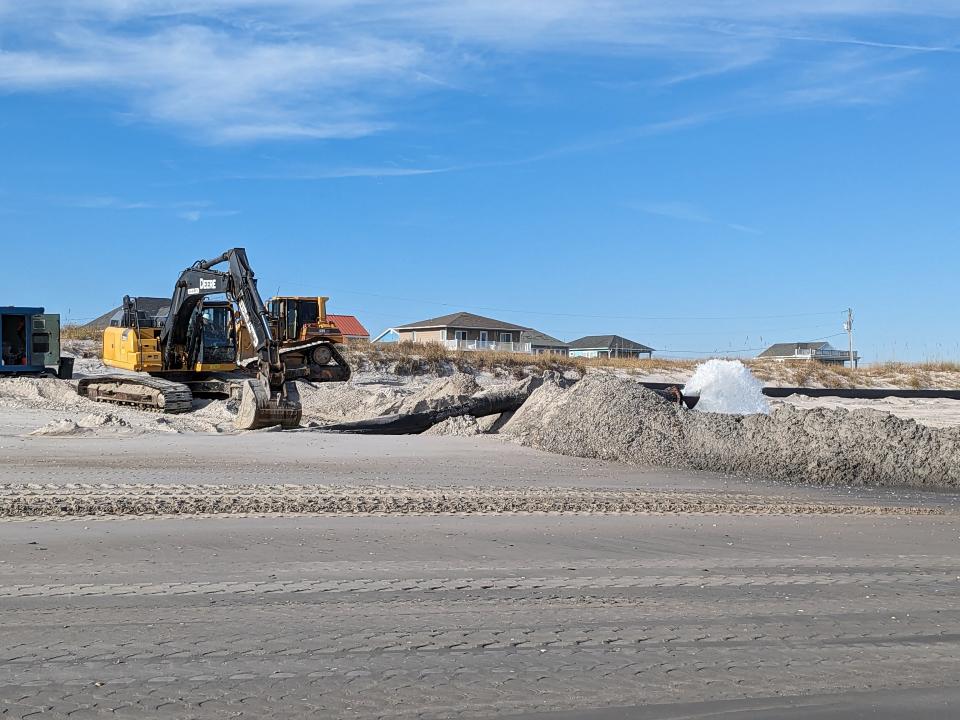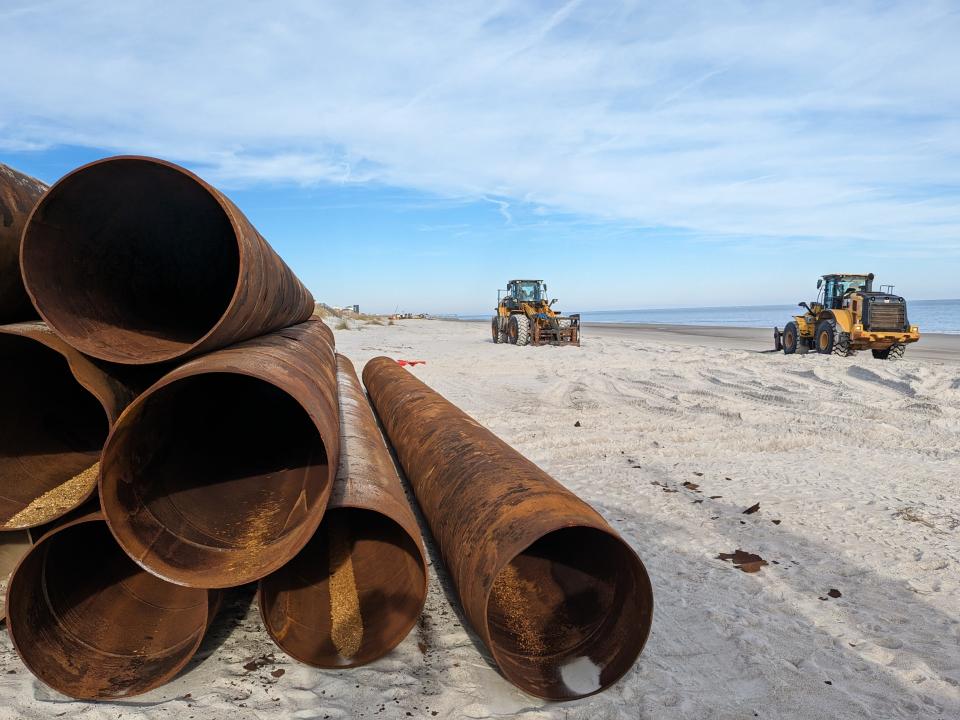Showing winter isn't just for Santa, nourishment projects start at Wilmington-area beaches
As temperatures dip and the days grow shorter, most beaches in Southeastern North Carolina are largely abandoned to migrating birds and a few hardy locals dressed for the season as winter grips the coast.
But not all, because the cooler weather and miles of largely tourist-free coastline is also a sign for heavy machinery and equipment to move in and help rebuild and stabilize the economic driver for many of the Cape Fear region's beach towns.
This winter dredging window for Topsail Beach in Pender County and Wrightsville Beach in New Hanover County will see major beach-building projects. While other beaches in the area could see activity associated with fresh sand from nearby inlet maintenance dredging, including work in Rich Inlet that separates Figure Eight Island and Wrightsville Beach, those two are the biggest beach nourishment projects planned for the Wilmington area before the end of March. That's when work is mandated by federal regulators to stop except in rare cases to help protect marine life and nesting sea turtles and shorebirds.
While beach nourishment is often criticized by environmentalists and others as being a short-term, expensive fix for a long-term problem, namely trying to protect oceanfront property built in areas prone to erosion and increased danger from sea-level rise and hurricanes due to climate change, coastal officials and many residents see it as the best way to protect valuable property, vital tax base, and sustain most beach towns' primary source of jobs and income.
SHIFTING SANDS Why did the National Park Service buy threatened oceanfront homes on the Outer Banks?
Topsail Beach

Piping and heavy equipment for the Pender County beach town's nourishment project, with sand coming from nearby channels and New Topsail Inlet, began hitting Topsail's beach Nov. 16.
Work on boosting the beach has focused on the southern part of the town's beach and around the water tower area, with other areas to receive fresh sand later this month and in early 2024.
The project was expected to cost $22.5 million. But at a board of commissioners' meeting last month Chris Gibson, the town's engineering contractor, told Topsail Beach officials that recent survey work showed shoaling in some channel areas was worse than anticipated. He said dredging the additional 350,000 cubic yards, boosting the overall project size to nearly 1.95 million cubic yards of material, could add up to $3.5 million to the project's cost. That added amount, however, would likely be covered by funds from the Federal Emergency Management Agency (FEMA). Gibson also noted that the additional dredged material getting placed on the oceanfront means Topsail would likely see its beach grow by 160 feet south of the town pier, where erosion has been the worst, and an extra 140 feet of width north of the pier.
Along with forcing the temporary closure of some beach accesses and detours on several streets due to pipes transporting the sand from areas on the Intracoastal Waterway side of the barrier island to the beach, Topsail officials also have decided to cancel this year's sale of beach access permits for vehicles and horses. Officials said safety concerns, with much of the beachfront littered with heavy equipment and piping that is constantly getting moved around, prompted the move.
Topsail officials have said the nourishment project should wrap up around early March.
Wrightsville Beach

After a torturous delay of more than two years, the New Hanover County beach town will finally see a fresh injection of sand for its eroded beach starting in mid-December.
Town Manager Tim Owens announced late last month that the beach nourishment project, which will be constructed from south to north, will start Dec. 17.
"The project includes the placement of 1 million cubic yards of sand on the beach from just south of the Blockade Runner Resort (Seashore Street) to just north of the Holiday Inn Resort Lumina on Wrightsville Beach (Access #8)," he stated in a release. "The project completion date is yet to be determined but likely sometime between March and April 2024."
The delay in Wrightsville seeing new sand for its engineered beach was largely due to a dispute over where the new sand should come from. What had been a skirmish over language broke out into a full-fledged sand war in 2021 when the Biden administration decided to enforce a rule that prohibits sand from federally designated Coastal Barrier Resources Act (CBRA) zones, like Masonboro Inlet, from being used for projects outside the zone. The CBRA zone designation is meant to prohibit expenditure of federal dollars on projects in hazardous coastal areas.

But local officials said the town had used sand from the inlet to nourish its beach every few years since the 1960s with no problems, noting the project also helped keep Masonboro Inlet open and safe for boaters. Without access to the inlet's sand, Wrightsville Beach would have to go looking offshore for sand − a move that would require jumping through several regulatory hoops to make sure the sand was safe to be mined and pumped onto the beach.
SAND WAR Wrightsville Beach wants Masonboro Inlet sand for nourishment. Feds say birds need it more
This summer the Army Corps of Engineers announced it was issuing an "emergency exception" to allow Wrightsville Beach to circumnavigate the CBRA ban and use sand for its beach from its historical Masonboro Inlet borrow area. The move came after local officials pressured the federal government to approve a waiver because of the precarious state of Wrightsville's beach, the potential safety threat to people, property and vital infrastructure from erosion and overwash events, and the historical use of the inlet sand in the past.
In September the corps awarded a $13.6 million contract to Marinex Construction for the nourishment project. Because of the delay to the project, U.S. Rep. David Rouzer, who represents Southeastern North Carolina in Washington, was able to secure federal funds to cover all of the nourishment's cost rather than the state and local governments also having to shoulder some of the cost as is normally the case.
Reporter Gareth McGrath can be reached at GMcGrath@Gannett.com or @GarethMcGrathSN on Twitter. This story was produced with financial support from 1Earth Fund and the Prentice Foundation. The USA TODAY Network maintains full editorial control of the work.
This article originally appeared on Wilmington StarNews: Wilmington area beaches begin winter nourishment projects

